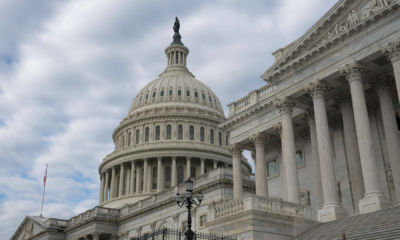NEWS
Mortgage Demand Drops As Rates Reach Highest Level In Over 20 Years
Published
8 months agoon

Courtesy of Clever Real Estate
Mortgage applications in the U.S. continued to decrease last week as mortgage rates climbed to their highest level in nearly 23 years, according to the latest report from the Mortgage Bankers Association.
The volume of mortgage applications in the week ending Sept. 22 declined 1.3% from the week before on a seasonally adjusted basis, according to the MBA’s Weekly Mortgage Applications Survey.
“Mortgage rates moved to their highest levels in over 20 years as Treasury yields increased late last week,” MBA Vice President and Deputy Chief Economist Joel Kan said in a statement.
“Based on the FOMC’s most recent projections, rates are expected to be higher for longer, which drove the increase in Treasury yields,” Kan said, referring to the Federal Reserve’s Federal Open Market Committee.
The average interest rate for 30-year fixed-rate mortgages with conforming loan balances of $726,200 or less increased last week to 7.41%, the highest level since December 2000, from 7.31% the week before. The average rate for 30-year fixed-rate mortgages for so-called jumbo loans with higher balances increased to 7.34%, the highest level since the jumbo rate was introduced in 2011, from 7.32% the week before.
“Overall applications declined, as both prospective homebuyers and homeowners continue to feel the impact of these elevated rates. The purchase market, which is still facing limited for-sale inventory and eroded purchasing power, saw applications down over the week and 27 percent behind last year’s pace,” Kan said.
“We are going to see a major logjam in the real estate market. People have seen massive increases in their home equity over the past few years, but leaving a 3% mortgage to jump to a 7% mortgage just doesn’t make sense for a lot of families right now. This is in part why you see a decrease in mortgage applications,” financial expert Ted Jenkin said.
The Federal Reserve last week decided to hold interest rates steady after 18 months of aggressive hikes, citing progress in its battle against inflation.
The central bank maintained the target range for the federal funds rate at 5.25% to 5.5%. In a statement announcing the decision, the Fed said although inflation remains above its target of 2%, job gains have slowed.
“Tighter credit conditions for households and businesses are likely to weigh on economic activity, hiring, and inflation,” the Fed said in a statement.
The Bureau of Labor Statistics last month reported consumer prices were up 3.7% year-over-year, above the Fed’s target but down from the 2022 peak of 9.1%.
The Federal Open Market Committee is scheduled to meet again on Oct. 31, and will be looking at consumer prices and jobs data to determine whether further rate hikes are needed to combat inflation.
“We want to see convincing evidence really that we have reached the appropriate level, and we’re seeing progress and we welcome that. But, you know, we need to see more progress before we’ll be willing to reach that conclusion,” Federal Reserve Chair Jerome Powell said at a press conference.
“A decline in mortgage applications is to be expected with rate increases but is actually a sign of the strength of the real estate demand that the more than doubling of interest rates we have seen still leaves in a seller’s market,” Joshua Cadillac, a real estate professional, said.
Cadillac continued: “There are still currently not enough homes to match the number of ready willing and able buyers that are currently in the market. While these rates serve as a deterrent to home purchases, it is largely counteracted by another phenomenon in an inflationary market which is that when rates go up rents tend to do so too. Buyers are then left with the choice to lock in their payment with a mortgage at a rate they don’t like or deal with the unknown moving target of rents that continue to inexorably move up.”
TMX contributed to this article.
More Money + Investing
-


7 Out of 10 Healthcare Workers Are Stressed About Their…
-


48,000 Mattresses Sold at Costco Under Recall for Reported Mold
-


US Diesel Supplier Warns of East Coast Shortage
-


Toys R Us is relaunching
-


Twitter to sue Elon Musk
-


Boeing workers to strike
-


Investors reduce their equity exposure
-


The economy barely grew in the previous quarter
-


Fed prepares another rate hike
-


4 Harmful Penny Pinching Habits That Are Sabotaging Retired Boomers
-


Apple Expected to Unveil New iPhone 15 Lineup Tuesday
-


Fed likely to significant increase interest rates significantly
